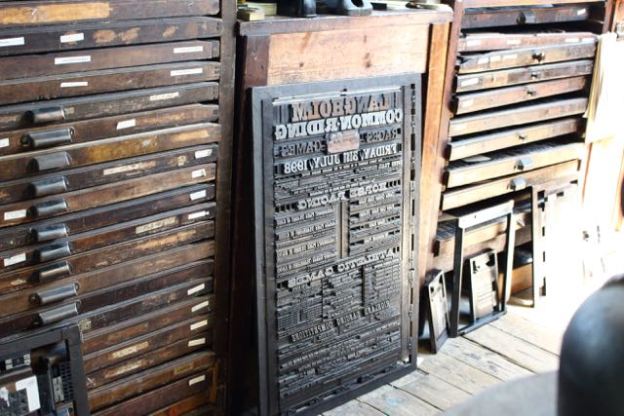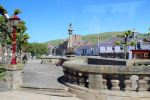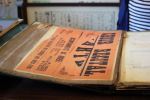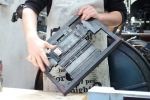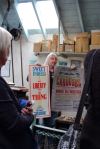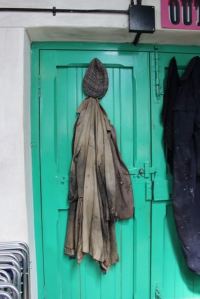 The visit to Robert Smail’s Printing Works in Innerleithen on Thursday 2nd June 2016 was the first event for the volunteers as part of Northern Print‘s ‘Letterpress – A Lasting Impression’ project, kindly funded by the Heritage Lottery Fund.
The visit to Robert Smail’s Printing Works in Innerleithen on Thursday 2nd June 2016 was the first event for the volunteers as part of Northern Print‘s ‘Letterpress – A Lasting Impression’ project, kindly funded by the Heritage Lottery Fund.
We started out from Northern Print on a damp grey morning, and the little bus was full of excited chatter as we headed out of Newcastle. As we reached Carter Bar, the border between Scotland and England, the weather changed to blue sky and sunshine. The towns we passed through seemed familiar from The People’s Friend illustrations I vaguely remember decades ago from childhood. The Borders landscape looked lovely as we made our steady progress along the winding road.
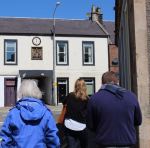 Innerleithen was sunny when we arrived. We were led to an unassuming wooden door in the main street which opened onto a narrow passageway where we were warmly greeted and ushered through to a little courtyard at the heart of the works.
Innerleithen was sunny when we arrived. We were led to an unassuming wooden door in the main street which opened onto a narrow passageway where we were warmly greeted and ushered through to a little courtyard at the heart of the works.
To one side of us was the office and shop, to the other side of us was the paper store, caseroom and machine room, and ahead was the lade (the Scottish word for an artificial watercourse known in England as ‘mill lead’ or ‘mill race’). The lade was the source of power for the printing works and for the woollen mills in the 19th century. It currently doesn’t have enough water to provide the force necessary to turn the printing works’ waterwheel partly due to the sluice gate from the Leithen not working.
We started the tour in the office where we heard about a brief history of how Robert Smail founded the printing works in 1866, how it was made possible by the woollen mills needing things printed, and how it became a National Trust for Scotland property and was conserved after the last Smail owner retired in the 1980s. Replica guard books (like big, properly bound scrap books, forming an archive of work done) show examples of the work done by the printing works in the past. The current staff continue this tradition by putting examples of the work they do in new guard books.
Crossing the yard to the paper store, we saw the undershot water wheel from inside and saw it working (powered by electricity) to give us an idea of what it was like when that was the lade was the power source.
Upstairs was the well-lit, lovely caseroom, full of intriguing cases of type. Gen the compositor told us of the main requirements for a printer’s apprentice. She explained how the cases in which the type is kept are organised. I hadn’t realised that the compartments in the cases were arranged according to how frequently letters and many characters were used so those used most often and in greatest quantity have bigger compartments in the centre of the case so they’re easier to get (upper case contains the capital letters, of course, and the lower case the small letter and punctuation). She also told us that Scottish and English cases are arranged a bit differently, and there can be some differences according as to who decided on the order originally.
We each typeset a short line of metal type on a composing stick and Gen printed each for us on a manually operated Columbian press. These presses were designed in the early 19th century and were a common printing press in the 19th century. I love them, not least because I was familiar with one in our art room at school, belonging to our art teacher. I loved that it had serpents and an eagle and a wonderful solidity and was beautifully made (probably have a drawing somewhere of that one). The typesetting was a bit easier than I expected, partly because it was just one short line we were composing, and partly because we were doing it upside-down so were still working left-to-right. The important thing was whether the type is put back into the right compartments (apprentices with young, sharp eyesight would have put them back in the old days). The framework that the type is put into for printing is called a forme.
After an enjoyable lunch at a café over the road with a fascinating railways theme (including artefacts dotted around), we went back to see the machine room. The Printer’s Apprentice and the Printer showed us different types of press, starting with the 19th century treadle-operated clamshell type that automated the inking up.
We all oohed and aahed over the tiny Adana presses
(I find that printmakers do tend to get a bit enamoured of tiny but proper presses – we’d all happily have one).
The big Wharfedale Reliance press, originally designed in the mid-19th century, is a belt-driven machine and apparently the belt can sometimes come off when it starts up because the electric power starts it up a bit more forcefully than the water power for which it was originally designed. This machine was added to Robert Smail’s Printing Works in the 1870s. The paper is rolled over the forme by a cylinder and is then stacked by the machine.
Finally, we saw the early 1950s automated Heidelberg press in action which can print without needing someone to feed in the paper. It was fascinating to watch these presses in action.
I liked the detail of the old cap and overall hanging on the back of the door of the machine room.
As we went back through the paper store, I think most of us would have quite happily spent a couple more hours just looking at what was stacked on the shelves.
I could also have spent at least another hour looking at the contents of the office as we passed through again on our way to the shop (which, unlike most heritage property shops, was originally a shop).
Eventually, we reluctantly left to return to Newcastle, a happy but tired bunch of printmakers who were a lot quieter on the way back than on the way there as we thought about what we’d seen (and quite a few of us might have closed our eyes for a while).
At the end of the day, I felt keen to sort type into order, to learn more about letterpress; and thought if I could drive that far, I’d happily visit Robert Smail’s Printing Works again.
